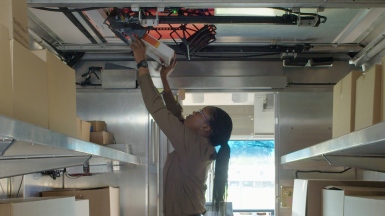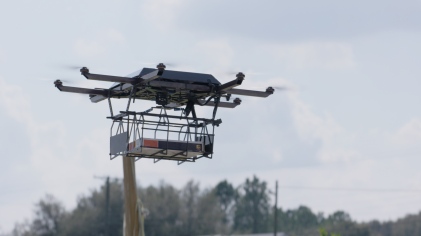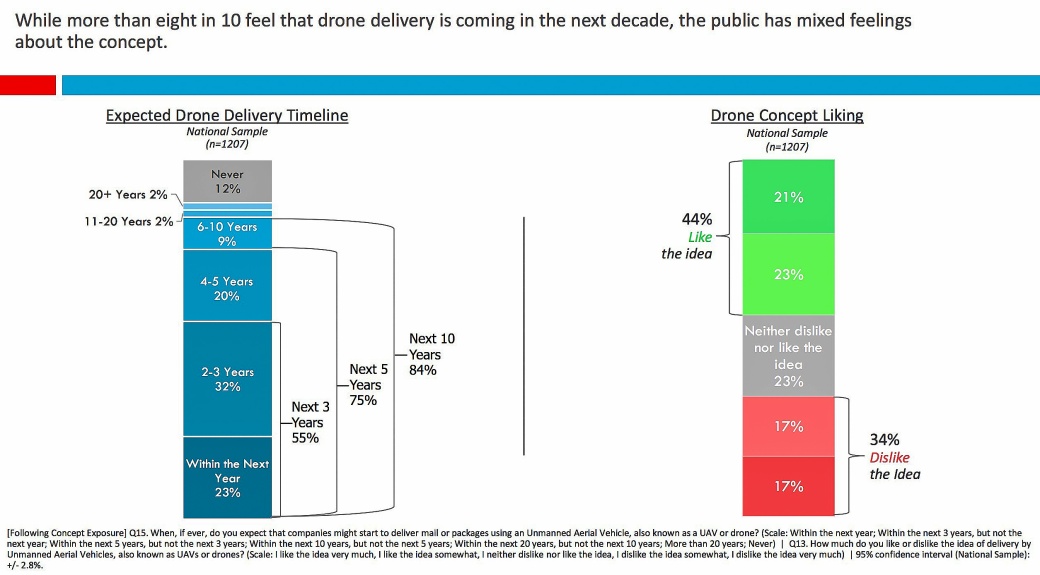Most people may not know that UPS has already been working with drone deliveries since 2016. Through partner Zipline it focused on delivering blood and medical supplies in Rwanda. In Boston, it partnered with drone-marker CyPhy to test making drone deliveries to remote locations such as to Children’s Island off the coast of Massachusetts. Its work in Florida is the first time that it has begun to test how drone delivery might fit into its daily operations.
UPS envisions using the drones in last-mile delivery from UPS trucks while drivers are out making other deliveries. From UPS’s perspective, they believe that the drones will increase driver productivity – particularly in rural areas where roads may not be wide enough to accommodate UPS trucks, road conditions are less than idea or houses are far apart. To this end, UPS launched a pilot project in Florida to test drone delivery as part of its daily operations from its vans. UPS purchased 350 modified Horsefly drones from Workhorse Group Inc. UPS hopes that drone deliveries will generate cost savings through reduced the number of miles driven per driver and reduced wear and tear on vehicles. Additionally, this should enable the same number of drivers to make more delivers per day during peak season.
UPS DRONE SPECS:
Category Specifications Empty Weight: 9.5 lbs. / 4.3 kg (without battery) Payload Volume: 0.6 cu. ft/0.01699 cu. m Drone Configuration: 8-rotor Octocopter Guidance System(s): Autonomous GPS & Compass (in-flight guidance system) LIDAR Infrared Camera (landing guidance system) Remote Human Monitored Navigation System: ORION (On-Road Integrated Optimization & Navigation) Max Flight Speed: 45 mph / 72.42 kph Battery Pack: Custom 18650 based battery pack Communication: 4G onboard Data Connection RF Transmitter Energy Use Cost: $0.03 per mile / $0.03 per 1.6 km
The Problem
However, there are a several of problems with UPS’s drone delivery system that it has failed to address. The problems with UPS’s drone delivery are in the delivery, the drones, and expansion drone delivery.
1) Delivery
Signing For Packages
UPS has yet to address how they will incorporate this into the drone delivery platform. As this is a keep feature of UPS’s service, it needs to be addressed. If UPS is planning on no longer collecting signatures for package deliveries made by drones or developing a new system it needs to start working with customers explain these changes. Possible changes could be through a combination of the use of IoT technology and recipients of packages taking a picture of the label.
No One Is At Home
Another problem that arises however is how to address if someone is not there to receive the package. Will the drone leave the package or return to the van with the package? How does the drone notify the homeowner that it attempted to make a delivery, but no one was at home? If it returns, the driver must spend time to unload the package from the drone and place it in the truck. Can the process of unloading the package, logging it, stowing it and then continuing to the next route be optimize to a point where it is as seamless as UPS’s current in person deliveries?
2) Drone
Load/Unload Process
 The video that UPS has released shows that the load and unload process is completely manual. To load the drone, the drive must load it after stopping the van before completing an in-person delivery. This manual process means that their is the potential for bottlenecks to arise in the delivery process as drivers search for packages to load into the drones and send them on their way. Optimizing the drone loading/unloading process is crucial. Having drivers struggling to load or unload the drones is something that cannot happen. Delays loading/unloading the drones means that drivers’ normal deliveries will be delayed, and delays will begin to stack up upon each other.
The video that UPS has released shows that the load and unload process is completely manual. To load the drone, the drive must load it after stopping the van before completing an in-person delivery. This manual process means that their is the potential for bottlenecks to arise in the delivery process as drivers search for packages to load into the drones and send them on their way. Optimizing the drone loading/unloading process is crucial. Having drivers struggling to load or unload the drones is something that cannot happen. Delays loading/unloading the drones means that drivers’ normal deliveries will be delayed, and delays will begin to stack up upon each other.
Drone Specifications (listed above)
UPS’s drones can carry packages that weight up to 10 pounds, reach speeds of up to 45 mph and have a maximum flight time of 30 minutes. Are these specs enough for UPS? Are enough of UPS’s packages under 10 pounds to where a significant number of packages can be handled by drone delivery? As consumers are shifting toward making more purchases online are these specs going to be enough moving forward for UPS to keep up with consumer demand?
up to 10 pounds, reach speeds of up to 45 mph and have a maximum flight time of 30 minutes. Are these specs enough for UPS? Are enough of UPS’s packages under 10 pounds to where a significant number of packages can be handled by drone delivery? As consumers are shifting toward making more purchases online are these specs going to be enough moving forward for UPS to keep up with consumer demand?
Recharge Speed and Battery Capacity
Workhorse and UPS have said that the drones will recharge after landing on the truck. However, is the recharging station on the trucks able to charge the battery packs on the drones fast enough to enable the type of delivery schedule that UPS has envisioned? UPS wants the drones to be able to continuously be able to be delivering packages while the driver is out delivering a package in person. This would mean that the battery pack  would need to charge very quickly in order to enable this type of usage. Given that UPS still does not know that average flight time for the drones and average battery life over that flight time, keeping the drones battery packs recharged should be an issue that UPS should be monitoring. If UPS is not currently working with Workhorse to develop fast charging technology for the drones battery packs, it certainly needs to be looking toward the next generation of drones if it is planning on expanding its drone delivery service. While rural Florida maybe a suitable environment to test a drone with a flight time of 30 minutes, I don’t see how this is a viable delivery solution for other parts of the US where UPS might be targeting for residential drone deliveries. Additionally, as the drones have yet to encounter Florida’s inclement weather season, it will be interesting to see how the drones’ battery pack hold up in strong winds and rain.
would need to charge very quickly in order to enable this type of usage. Given that UPS still does not know that average flight time for the drones and average battery life over that flight time, keeping the drones battery packs recharged should be an issue that UPS should be monitoring. If UPS is not currently working with Workhorse to develop fast charging technology for the drones battery packs, it certainly needs to be looking toward the next generation of drones if it is planning on expanding its drone delivery service. While rural Florida maybe a suitable environment to test a drone with a flight time of 30 minutes, I don’t see how this is a viable delivery solution for other parts of the US where UPS might be targeting for residential drone deliveries. Additionally, as the drones have yet to encounter Florida’s inclement weather season, it will be interesting to see how the drones’ battery pack hold up in strong winds and rain.
3) Expansion
Americans’ Attitudes Toward Drones
According a 2016 survey conducted by the United States Postal Service, 55% of Americans expect drone deliveries to occur within the next 3-5 years. However, only 44% of Americans like the idea. 34% of American dislike the idea of drone deliveries, while 23% of American confess to neither disliking or liking the idea of drone deliveries. Additionally, many Americans express concerns about the safety of drones and their potential for malfunction. 78% of participants in the USPS survey stated that they have some concern that a drone will have some type of malfunction. The leading concerns were that the drone might malfunction and damage the package the it was carrying, injure someone or damage property.

Source: United States Postal Service
Solutions
1) Delivery
Signing For Packages
Developing new ways to verify that packages are delivered will be something that UPS needs to work on since drones will not carry a pad for people to sign. Using RFID package labels that can be tracked and have the end recipient take a picture of the label is one solution.
No One Is At Home
One solution is for the UPS van to send a push notification to the recipient’s cell phone when it is approaching the delivery at a specified time interval. UPS is now able to send push notifications via text messages to the end recipient’s phone. UPS can also utilize SNS apps to do this as well.
2) Drone
Load/Unload Process
Enough can’t be said about optimizing the loading and unloading of packages into the drone. Much like UPS optimized the in-person delivery through noticing how much time was being wasted by waiting for signatures, the drone load/unload process needs to be optimized. The way packages are loaded into vans and unloaded off the vans needs to be completely redesigned to support this. Even the interior of the vans may need to be redesigned somewhat to support faster loading of the drones. Just putting a drone on top of the van and having a fancy navigation system that can autonomously fly and deliver the package is not enough.
Drone Specifications
The drones specs hinge on how much of UPS’s volume is 10 lbs. or less and has volume that is 0.6 cubic feet. If not, these drones are not up to the task that UPS has set for them, and it needs to go back to the drawing board. Additionally, as it looks to expand this to other parts of the country, particularly in the Midwest, the 30 minute flight time may not be enough to reach a residence while the driver is making another delivery.
Recharge Speed and Battery Capacity
The type of delivery pattern that UPS envisions the drones to be making really will require fast charging once the drones land. In urban areas, the drones may only have a few minutes to charge. UPS needs to look into fast charging technology and/or longer lasting batteries in order to utilize the drones in the way that it envisions. Otherwise the drones may not be able to make as many flights as UPS wants. Studying the recharging speed of the drones while they are out, as well as the average flight times and average battery charge is very crucial for UPS.
3) Expansion
Americans’ Attitudes Toward Drones
UPS will have to work change Americans attitudes about drones over time. This is not something that will happen over night. Proving that drones can deliver packages safely to people will allay a people’s concerns and doubts about drones. Additionally, having a customers that receive deliveries via drone post pictures and video to SNS of their deliveries will help as well.
Urban Areas
The single drone design is great to start the pilot test. However, for this to be a truly viable platform moving forward to expand into urban areas UPS will need to be able to launch and recover more than a single drone from each van. UPS’s vans have enough roof space to launch two and possible three of the horsefly drones with the current configurations. It will be interesting to see if UPS plans to test deliveries of more than one drone. At $0.03 per mile for a drone delivery, it makes sense to expand the number of drones that can deliver packages from each UPS van. While a driver is delivering one package in person two or three drones can be making deliveries. If the loading process can truly be optimized or even automated within the van, the turnaround time for these deliveries in urban areas will be key for UPS in the last-mile delivery space.
This is where the money is at for last-mile delivery and where everyone is competing. Proving that they can deliver packages in rural areas is just a proof of concept. Next they will need to prove that they can do it in suburban areas, and up the ante by using more than one drone on a van. If UPS cannot launch more than one drone from a van the metropolitan areas are going to be tough to compete in. Especially against competitors such as Google, Amazon, USPS and FedEx that will certainly be looking at other angles of competition.